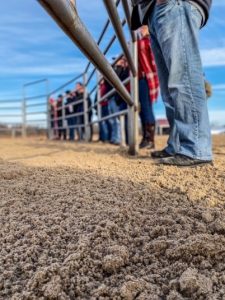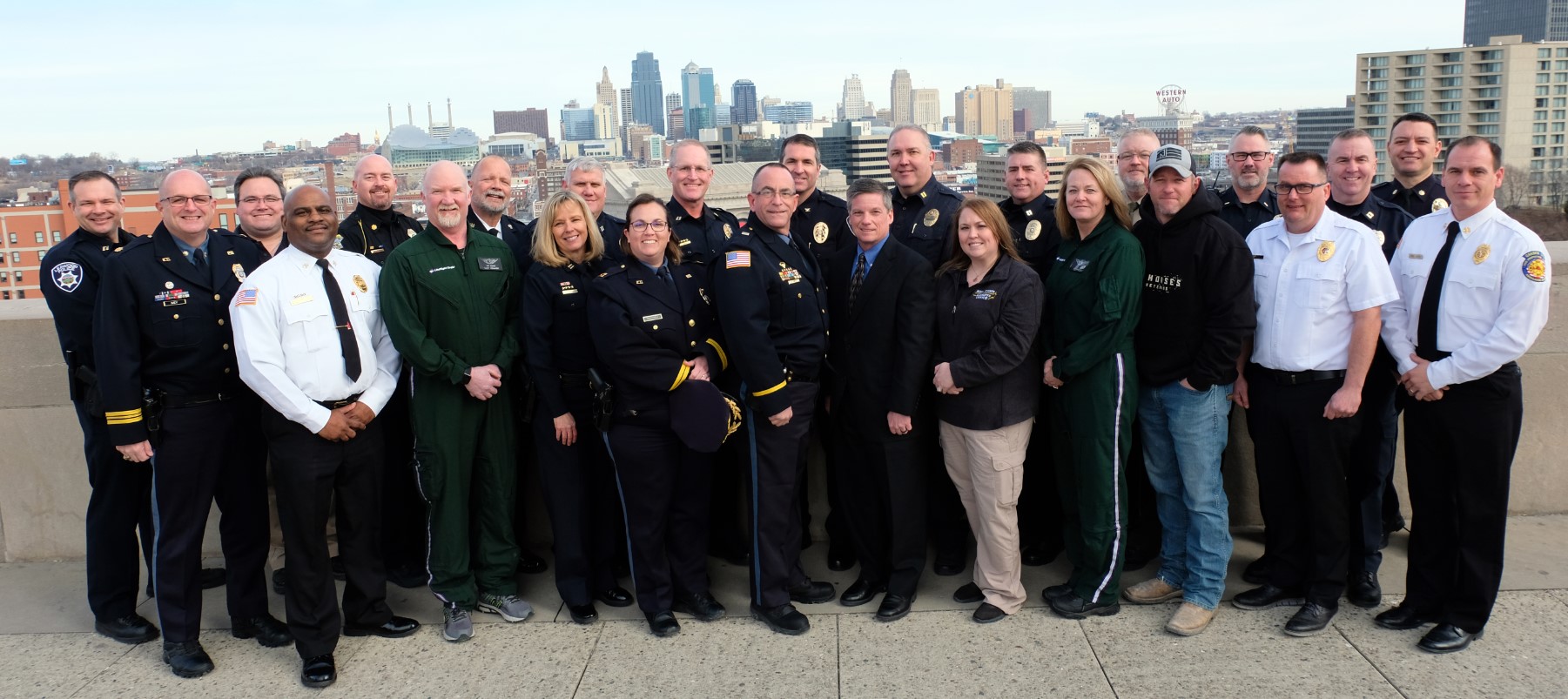Summer, the thousand-pound black Morgan horse was standing 14 hands high in the round pen looking at me as I opened the metal gate and stepped inside. My breathing quickened. I was terrified on the inside because 13 of my commander colleagues from my cohort were standing outside the round ring watching me. It was my turn to work on my communication and leadership skills by using a lunge whip to get the horse to do what I wanted it to do without saying anything. I walked to the side of the ring to meet the horse eye to eye, then I walked through the sand to meet Jason Klepac, War Horses for Veterans’ Tactical Longevity for First Responders program manager, in the middle of the pen for instructions. He told me to walk confidently to the horse, tall and with my shoulders back, stay at the front leg area, outstretch my arm and point my finger in the direction that I want the horse to go, whip the air with the lunge whip in the rear area of the horse once, and then start walking in the direction of my outstretched arm and pointed finger.
 Luckily, the horse started walking as directed, which was not the case for all of my colleagues. I saw how leadership styles differed in the round pen. There were some who repeatedly whipped the air with the lunge whip and did not give the horse the chance to follow the prompt to change direction before barking the next order, indicating a micro-managing style. Others gave the first order, let the horse follow directions, and then praised the horse after it did what they asked, indicating positive leadership skills. Each encounter was very eye-opening to not only the commander in the round pen, but also to the observers. It gave us a chance to recognize our styles while Klepac gave us advice on how to improve.
Luckily, the horse started walking as directed, which was not the case for all of my colleagues. I saw how leadership styles differed in the round pen. There were some who repeatedly whipped the air with the lunge whip and did not give the horse the chance to follow the prompt to change direction before barking the next order, indicating a micro-managing style. Others gave the first order, let the horse follow directions, and then praised the horse after it did what they asked, indicating positive leadership skills. Each encounter was very eye-opening to not only the commander in the round pen, but also to the observers. It gave us a chance to recognize our styles while Klepac gave us advice on how to improve.
The final exercise in the round pen was to put the reins up on the neck of the horse and walk away toward the opposite side of the round pen. If the horse followed, trust was built. If it did not follow, trust was not built, and more coaching work was done until the horse did follow.
While the equine workshop was intended as a lesson in leadership and communication skills, it was also an incredible experience to see how energy, breathing, and small non-verbal behavior—sometimes details that other humans don’t even consciously register—will affect a horse’s demeanor. “If you walk in high-strung, the horse will sense it and become high-strung. But if you walk in calm, the horse will be calm. They are very sensitive,” said Klepac.1
“The horse, Summer, gave me a power that I didn’t know I had. This exercise brought back my confidence,” said Lieutenant Dan Davis, Belton, Missouri, Police Department.2
The half-day equine workshop at War Horses for Veterans is the last step in the Commander Level Peer Support training, following a four-day classroom curriculum. The curriculum is designed and taught by Dr. Jennifer Prohaska, a licensed clinical psychologist who specializes in working with first responders. Training modules customized to the commander level cover tools for dealing with command stress, post-traumatic stress disorder in first responders, suicide risk and assessment, responding to line-of-duty deaths, retirement issues and a shifting identity, toxic leadership, practical applications of knowledge, and critical-incident stress debriefing scenarios. International Association of Chiefs of Police (IACP) guidelines, International Association of Fire Fighters (IAFF) guidelines, and state-level peer support confidentiality legislation are also incorporated into the training.
Dr. Prohaska has years of experience helping individuals and response professionals cope with trauma.
It’s a common misperception that once men and women take on more administrative roles and leave the field, they become immune to major traumatic stress, and that simply isn’t true. By the time commanders reach that point in their careers, they could have 20-plus years of accumulated stress and trauma from working on the front lines, plus the added burden of chronic stress that comes with command responsibilities.3
Once commanders complete the training, they are eligible to join the Commander Level Peer Support Team. This 52-member team—believed to be first of its kind in the United States—includes cross-discipline commanders from fire, EMS, law enforcement, and dispatch. They respond to critical incidents to support command-level leaders. While there are peer support teams in place for frontline staff, it’s not always advisable for a commander to talk about personal issues with his or her employees. Commanders need to be able to talk to a colleague who is on the same level they are, with the capacity to experientially understand command-specific stressors on a more comprehensive level.
The team defines a commander as someone with a rank higher than a sergeant in law enforcement and as a battalion chief or higher in fire/EMS. Since the team’s inception in July 2018, team members have deployed to 22 critical incident stress debriefings . They have also fielded hundreds of phone calls from commanders all over the United States and Canada as a result of magazine articles in practitioner publications and numerous conference presentations.
Peer support fills a need that cannot be met by typical employee assistance programs or department psychologists or chaplains. Peer support can be immediate, taking place right after a call or even while still on the scene of an incident. Peers do the same job as those whom they support and often understand each other’s stress in ways someone on the outside cannot. Peer support training augments other parts of an overall mental wellness program within an agency, but it is not intended to replace professional help. A peer support program is proactive and preventive in nature, helping to identify challenges and impacts immediately after an incident, before the mental health risks become more serious. Peer support team members are trained to provide accessible, practical, and de-stigmatized support to personnel during times of work-related and personal crisis. They may also make referrals to professionals when a higher level of care is needed.
In July 2018, MARC launched a Commander Level Peer Support pilot program with 12 commanders. The program has since grown into a team of 52 trained commanders (including some retired commanders) who are led by the peer support program planner, two co-chairs (one each from Missouri and Kansas), and several other team members, with oversight from Dr. Prohaska. The Commander Level Peer Support Team is working to establish subcommittees to manage the workload. The subcommittees track anniversary dates of suicide, court decisions, and other key events. Additionally, they provide support for funeral arrangements and family issues and offer social activities for networking. The Commander Level Peer Support Team is working to add marriage/partner workshops and financial health classes to the wellness portion of the program. Topics such as mindfulness and meditation, building resiliency, surviving secondary trauma, and yoga are already included in the program’s continuing education, and team members are highly encouraged to attend workshops or programs on those topics. The team partners with First Responders Support Team Midwest to provide frontline-level staff peer support and mental health retreats.
Recently, it was realized that the LGBTQ+ community was not well represented in the peer support team. MARC contracted with Inoru Wade, executive director of Midwest Rainbow Research Institute, to provide a three-hour MO-POST certified training to the team and provided team members small rainbow lapel pins that can be worn on uniforms to denote an LGBTQ+ trained peer supporter and can be seen as a symbol of safety.
The commander level peer support team members are ready to offer our fellow leaders a confidential safe place to take your commander superhero capes off momentarily. You can talk about professional and personal situations that may be bothering you. You are not alone.
“Our goal is that commanders know they have a team of their own to reach out to in times of need, across jurisdictions and across first responder disciplines,” said Michael Daniels, MARC’s public safety communications operations manager and recently retired police chief of Merriam, Kansas, Police Department. “Healthy commanders make healthy agencies.”4
 Pam Opoka, ENP, is the public safety training coordinator and peer support program planner at Mid-America Regional Council (MARC). She has over 25 years of experience in public safety and has a master’s degree in public administration, with certification in performance management. Pam is active in university research projects and workgroups within the National Emergency Number Association (NENA). She is currently the co-chair of NENA’s Wellness Committee Peer Support Work Group. Pam Opoka, ENP, is the public safety training coordinator and peer support program planner at Mid-America Regional Council (MARC). She has over 25 years of experience in public safety and has a master’s degree in public administration, with certification in performance management. Pam is active in university research projects and workgroups within the National Emergency Number Association (NENA). She is currently the co-chair of NENA’s Wellness Committee Peer Support Work Group. |
Notes:
1 Jason Klepac (Tactical Longevity for First Responders program manager, War Horses for Veterans), personal conversation, January 30, 2020.
2 Dan Davis (lieutenant, Belton, Missouri, Police Department), personal conversation, January 30, 2020.
3 Jennifer Prohaska (clinical psychologist), personal conversation, January 30, 2020.
4 Michael Daniels (public safety communications Manager, MARC), email, April 29, 2020.
Please cite as:
Pam Opoka, “A Safe Place to Remove Your Cape: Commander Level Peer Support Team,” Police Chief Online, May 5, 2020.



